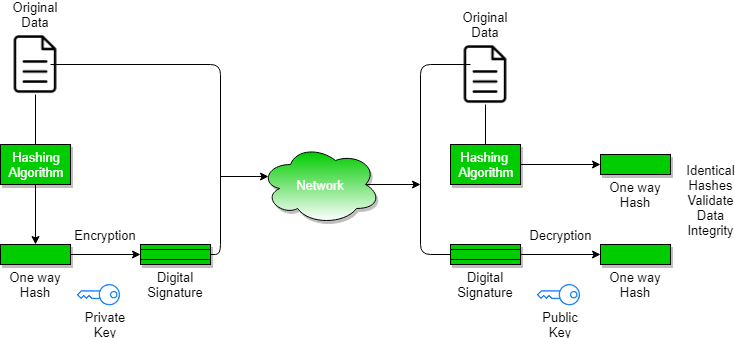Digital Signature - Detailed Explanation
A digital signature is a mathematical technique used to validate the authenticity and integrity of a message, software or digital document.
- Key Generation Algorithms : Digital signature are electronic signatures, which assures that the message was sent by a particular sender.
- Signing Algorithms: To create a digital signature, signing algorithms like email programs create a one-way hash of the electronic data which is to be signed. The signing algorithm then encrypts the hash value using the private key (signature key). This encrypted hash along with other information like the hashing algorithm is the digital signature. This digital signature is appended with the data and sent to the verifier. The reason for encrypting the hash instead of the entire message or document is that a hash function converts any arbitrary input into a much shorter fixed length value. This saves time as now instead of signing a long message a shorter hash value has to be signed and moreover hashing is much faster than signing.
- Signature Verification Algorithms : Verifier receives Digital Signature along with the data. It then uses Verification algorithm to process on the digital signature and the public key (verification key) and generates some value. It also applies the same hash function on the received data and generates a hash value. Then the hash value and the output of the verification algorithm are compared. If they both are equal, then the digital signature is valid else it is invalid.
The steps followed in creating digital signature are :
- Message digest is computed by applying hash function on the message and then message digest is encrypted using private key of sender to form the digital signature. (digital signature = encryption (private key of sender, message digest) and message digest = message digest algorithm(message)).
- Digital signature is then transmitted with the message.(message + digital signature is transmitted)
- Receiver decrypts the digital signature using the public key of sender.(This assures authenticity,as only sender has his private key so only sender can encrypt using his private key which can thus be decrypted by sender’s public key).
- The receiver now has the message digest.
- The receiver can compute the message digest from the message (actual message is sent with the digital signature).
- The message digest computed by receiver and the message digest (got by decryption on digital signature) need to be same for ensuring integrity.
Message digest is computed using one-way hash function, i.e. a hash fucntion in which computation of hash value of a is easy but computation of a from hash value of a is very difficult.

Digital Certificate
Digital certificate is issued by a trusted third party which proves sender's identity to the receiver and receiver’s identity to the sender.
A digital certificate is a certificate issued by a Certificate Authority (CA) to verify the identity of the certificate holder. The CA issues an encrypted digital certificate containing the applicant’s public key and a variety of other identification information. Digital signature is used to attach public key with a particular individual or an entity.
Digital certificate contains:-
- Name of certificate holder.
- Serial number which is used to uniquely identify a certificate, the individual or the entity identified by the certificate
- Expiration dates.
- Copy of certificate holder's public key.(used for encrypting messages and digital signatures)
- Digital Signature of the certificate issuing authority.
Digital ceritifcate is also sent with the digital signature and the message.
Digital certificate vs digital signature :
Digital signature is used to verify authenticity, integrity, non-repudiation ,i.e. it is assuring that the message is sent by the known user and not modified, while digital certificate is used to verify the identity of the user, maybe sender or receiver. Thus, digital signature and certificate are different kind of things but both are used for security. Most websites use digital certificate to enhance trust of their users.






0 comments:
Post a Comment